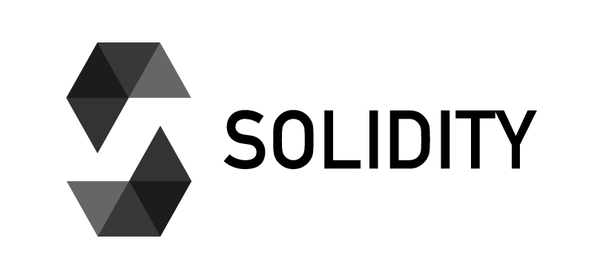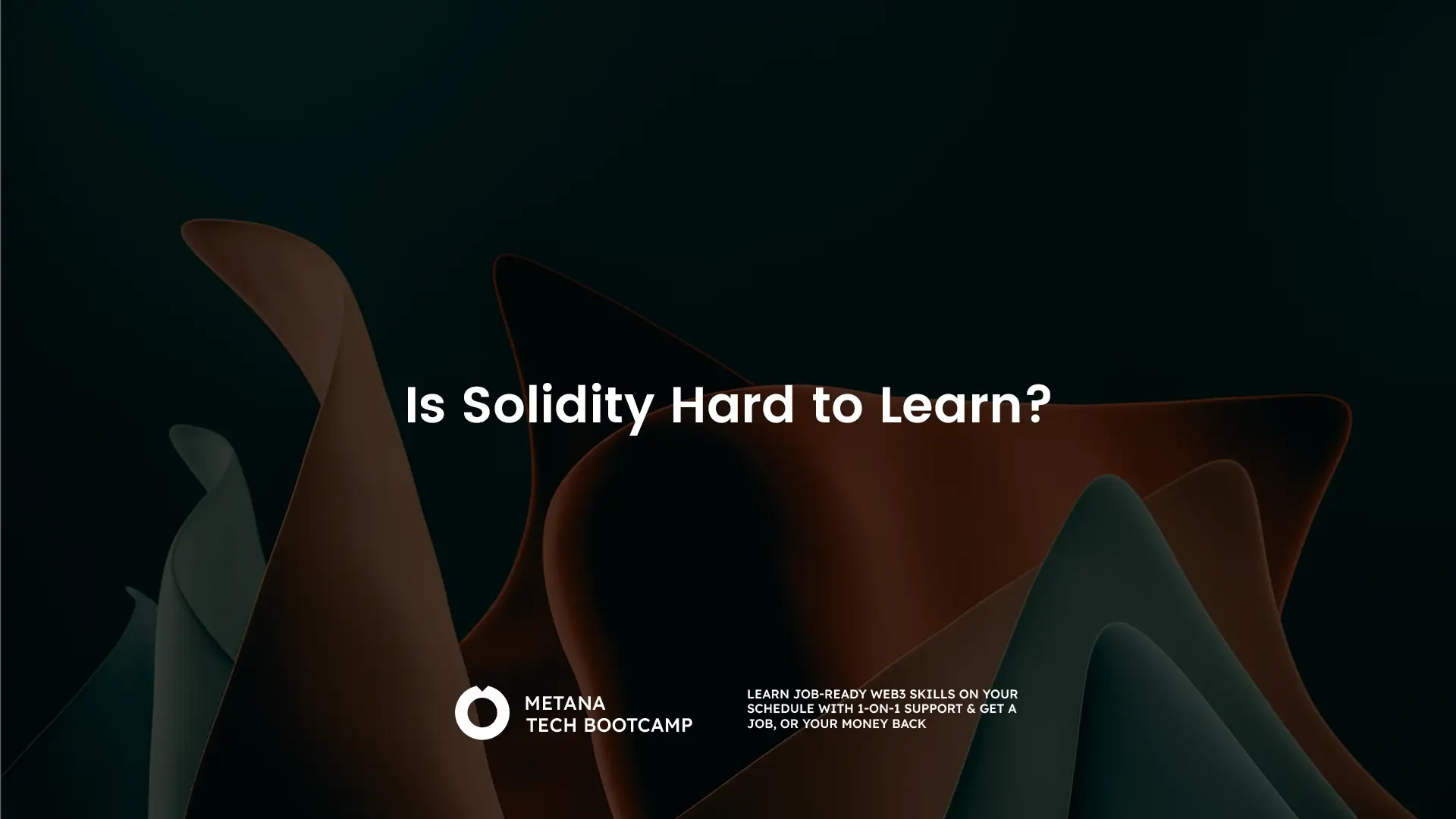TL;DR
- Solidity is relatively easy to learn for those with JavaScript or C++ experience due to its similar syntax, but becomes more complex when building advanced smart contracts
- The language is beginner-friendly, but mastering it requires understanding blockchain concepts, Ethereum ecosystem, and security best practices
- Learning resources are abundant, including documentation, tutorials, and an active community that can help newcomers
- While the syntax is straightforward, the stakes are high since programming mistakes in smart contracts can lead to significant financial losses
- To become proficient, developers should practice with simple contracts on test networks, join the community, and follow established security best practices
We at Metana, believe that the learning Solidity programming language is essential for building decentralized applications (dApps) on the Ethereum blockchain. It is a high-level object-oriented language with a syntax similar to JavaScript and C++, designed specifically for writing smart contracts that execute automatically when certain conditions are met. In this article, we will explain why Solidity is easy to learn but tough to master, and how you can improve your Solidity skills to create secure and efficient smart contracts.

The Basics of Solidity Syntax
Solidity is a statically typed language, meaning that you have to declare the data type of a variable before using it. Solidity supports various data types, including integers, booleans, strings, and arrays, as well as more complex types such as structs and mappings. It also has built-in functions and libraries for performing common tasks, such as mathematical operations and string manipulation.
One of the reasons why Solidity is easy to learn is its similarity to other programming languages. If you have experience with JavaScript or C++, you will find the syntax of Solidity quite familiar. Solidity code is also easy to read and understand, thanks to its clear and concise syntax.
Here is an example of a simple Solidity contract:
contract MyContract {
uint public value;
function set(uint v) public {
value = v;
}
function get() public view returns (uint) {
return value;
}
}The Complexity of Solidity Programming
However, Solidity programming can quickly become complex when you start building more complex smart contracts. Solidity smart contracts can interact with other contracts, receive and send ether (the cryptocurrency used on the Ethereum network), and store and retrieve data on the blockchain. Solidity also has some unique features, such as the ability to define modifiers and events, that require a deeper understanding of the language.
To master Solidity, you need to have a good understanding of programming concepts such as data structures, control flow, and object-oriented design. You also need to be familiar with the Ethereum ecosystem, including its gas fees, transaction ordering, and consensus mechanism. Solidity programming also requires attention to detail and a thorough understanding of the security implications of each line of code. A poorly written smart contract can lead to catastrophic consequences, such as the loss of funds or the compromise of sensitive data.
Improving Your Solidity Skills
To improve your Solidity skills, we recommend the following steps:
- Start by reading the official Solidity documentation, which provides a comprehensive guide to the language’s syntax and features.
- Practice writing simple smart contracts, such as a token contract or a voting contract, and deploy them on a test network such as Sepolia and Goerli
- Join the Solidity community, which is active on forums such as Reddit and Stack Exchange, and participate in hackathons and coding challenges.
- Follow best practices for Solidity development, such as using established libraries, writing unit tests, and performing security audits.
- Consider taking a Solidity course or working with a mentor who can provide feedback and guidance on your code.
By following these steps, you can become a master of Solidity programming and create robust and secure smart contracts that power the future of decentralized applications.
Is Solidity good for Beginners?
Learning Solidity can indeed be a good starting point for beginners interested in blockchain and Ethereum development, especially if they have prior experience with JavaScript, as the syntax is quite similar. However, understanding Solidity means not just familiarizing oneself with the language syntax, but also grasping the principles of smart contracts and blockchain.
Here’s why Solidity could be considered beginner-friendly:
- Syntax: Solidity’s syntax is heavily influenced by JavaScript and C++, both of which are mainstream programming languages with a wealth of learning resources.
- Resource Availability: Over the years, a substantial number of learning resources for Solidity have emerged, including documentation, online tutorials, coding bootcamps and courses. This makes learning the language more accessible for beginners.
- Ethereum Popularity: As the native language of Ethereum, the second-largest blockchain platform, Solidity has gained significant traction. This popularity translates into a larger community of developers that can assist and guide beginners.
- Wide Use Case: Learning Solidity opens doors to a wide range of possibilities, including creating smart contracts, building decentralized applications (DApps), and developing tokens under the ERC standards.
However, it’s also essential to note that programming with Solidity involves dealing with real-world assets on the blockchain, and mistakes can lead to significant loss of funds due to the immutable nature of the blockchain. As such, a certain degree of caution is necessary, especially when writing smart contracts that handle value. Therefore, while the language itself can be beginner-friendly, the stakes of programming in Solidity can be quite high.
Other opinions: Is Solidity Hard to Learn?
Opinions regarding Solidity’s difficulty level vary widely depending on the source. Some argue that Solidity is relatively easy to learn, while others contend that it is difficult to master. According to BestColleges, Solidity is “user-friendly for those with prior programming experience,” but it can take longer to learn for those without programming experience. Similarly, Soloman Korban notes that Solidity’s syntax is “easy to read and write” for those who are familiar with programming languages like JavaScript or C++, but beginners may find it challenging to learn.
Furthermore, Solidity has its own set of best practices and design patterns that developers must learn in order to write efficient and secure code. LearnerHive notes that Solidity’s lack of robust error handling and debugging tools can make it difficult for developers to identify and fix errors in their code. Additionally, Solidity’s limited documentation and community resources can make it challenging to find answers to specific questions or problems.
Conclusion
Is solidity hard to learn? No. Its clear and concise syntax makes it accessible to developers with experience in other programming languages, but its complexity increases as you start building more complex smart contracts. To become a Solidity expert, you need to have a deep understanding of programming concepts, the Ethereum ecosystem, and security best practices. By following our recommended steps, you can improve your Solidity skills and create smart contracts that are secure, efficient, and elegant.
Master building with Solidity and Land a Job in the industry in 4 months, apply to Metana’s Web3 Solidity Bootcamp
FAQs
- Who uses Solidity?
Solidity is used by developers who want to create smart contracts on the Ethereum blockchain. Some of the companies that use Solidity include:
- Aave
- MakerDAO
- Uniswap
- OpenSea
- Synthetix
- Chainlink
- Is Rust faster than Solidity?
Yes, Rust is generally faster than Solidity. This is because Rust is a compiled language, while Solidity is an interpreted language. Compiled languages are converted into machine code before they are executed, while interpreted languages are converted into machine code during runtime.
- Who is an NFT developer?
An NFT developer is a software developer who specializes in creating and developing non-fungible tokens (NFTs). NFTs are digital assets that are unique and cannot be replaced by another asset. They are often used to represent ownership of digital artworks, collectibles, and in-game items.
- Is Solidity still in demand?
Solidity developers are in high demand, and as a result, their salaries are on the rise.
- Which language is best for smart contracts?
Solidity is the most popular language for smart contract development. However, other languages such as Rust, Vyper, and C++ can also be used to write smart contracts.
- Does Bitcoin use Solidity?
No, Bitcoin does not use Solidity. Bitcoin is a blockchain network that uses its own scripting language called Script.
- What is the salary of a Solidity developer?
The salary of a Solidity developer can vary depending on their experience, skills, and location. However, according to Indeed, the average salary for a Solidity developer in the United States is $120,000 per year.
- Can I get a job if I learn Solidity?
Yes, you can get a job if you learn Solidity. There is a high demand for Solidity developers, and many companies are hiring for these positions.
- Does Solidity require math?
Yes, Solidity does require some knowledge of math. However, you do not need to be a math expert to learn Solidity. The basic math concepts that you need to know for Solidity include:
- Arithmetic
- Boolean logic
- Set theory
- Is Solidity similar to Python?
Yes, Solidity is similar to Python in some ways. Both languages are object-oriented and use curly braces to denote blocks of code. However, there are also some key differences between the two languages. For example, Solidity is a compiled language, while Python is an interpreted language.
- Is it worth learning Solidity?
Yes, it is worth learning Solidity. Solidity is a powerful language that can be used to create a variety of decentralized applications. The demand for Solidity developers is high, and the salary for these positions is also good.
- How long will it take to learn Solidity?
The amount of time it takes to learn Solidity will vary depending on your prior experience and learning speed. However, if you are a beginner, I would estimate that it would take you at least 3-6 months to learn the basics of Solidity.





